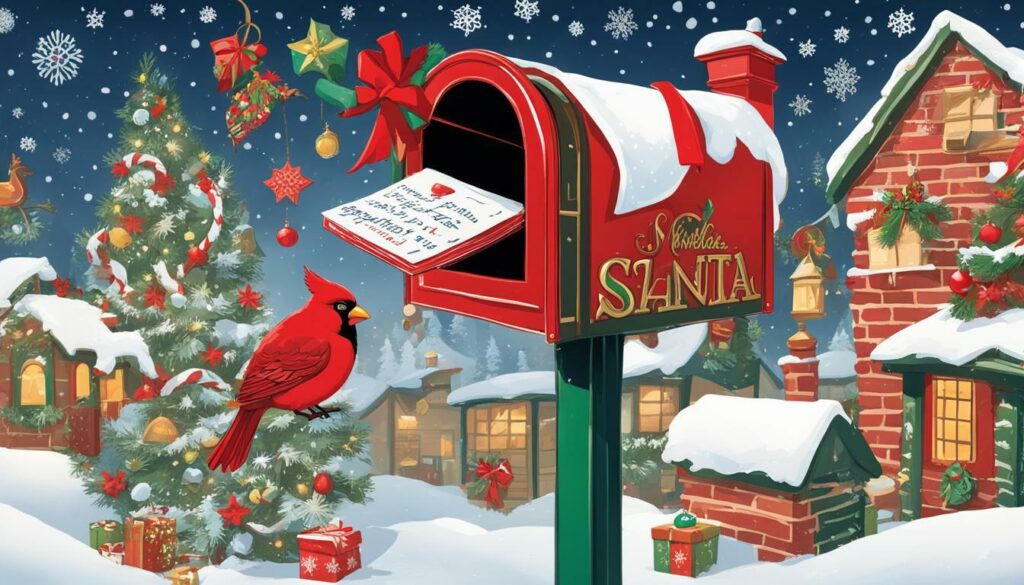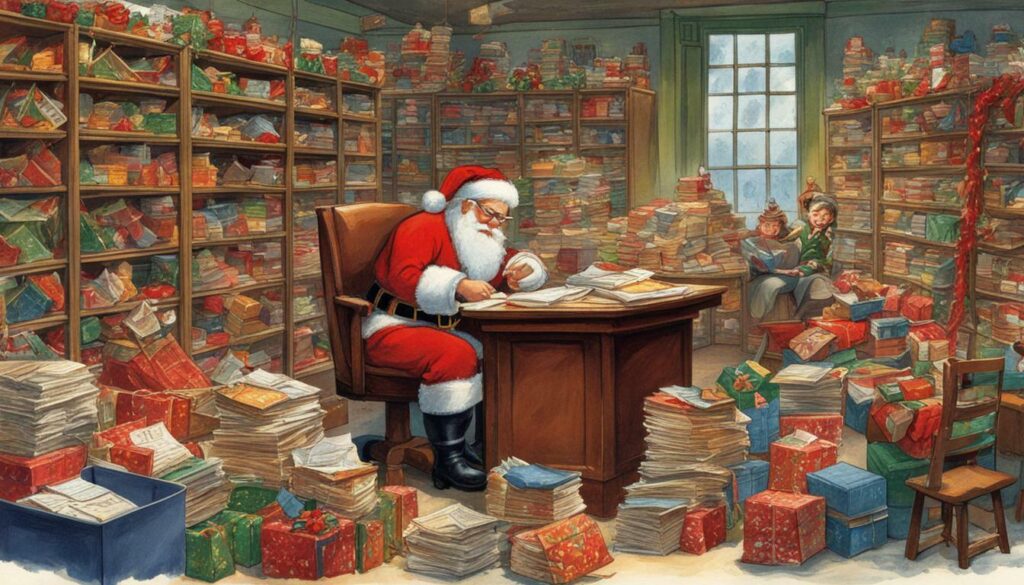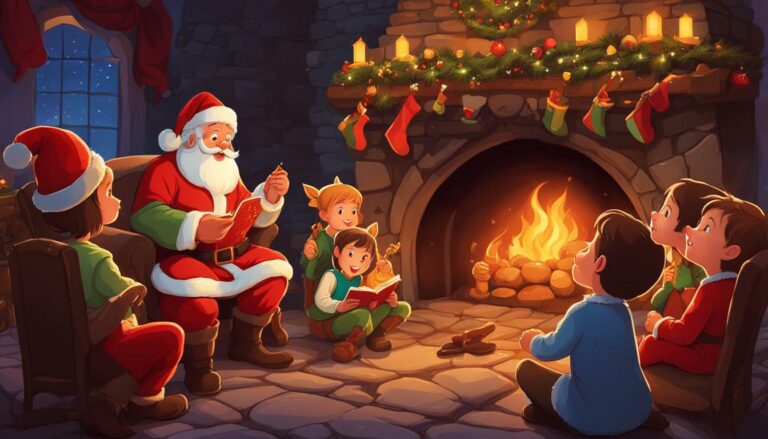Unfolding the History and Evolution of Santa Letters
Santa letters have a rich history and have evolved over time to become a beloved holiday tradition that keeps the spirit of Christmas alive. The tradition of writing letters to Santa Claus can be traced back to the 19th century when Santa was often portrayed as a disciplinary figure. These early Santa letters were didactic in nature, aiming to teach children about good behavior and the rewards they could expect from St. Nicholas.
As the postal system became more formalized in the mid-1800s, the practice of sending letters to Santa started to gain popularity. Illustrator Thomas Nast even depicted Santa sorting letters from “Good Children’s Parents” and “Naughty Children’s Parents,” contributing to the growing fascination with the tradition. Santa letters became a way for children to express their Christmas wishes and hopes directly to the man himself.
In the early 1900s, the Post Office Department allowed local charity groups to answer the letters, leading to the establishment of the Santa Claus Association in New York City. This organization coordinated the answering of thousands of letters each year, bringing joy to children across the country. However, the Santa Claus Association faced controversy when it was discovered that they were misusing funds, and the Post Office Department had to change its policy.
This policy change birthed Operation Santa Claus, an informal group of postal employees who took it upon themselves to respond to children’s letters and send them gifts. This grassroots movement gained popularity and even found its way into popular culture, with the movie “Miracle on 34th Street” showcasing the heartwarming impact of Santa letters.
Today, the tradition continues with the United States Postal Service (USPS) offering a program that allows parents to reply to their children’s letters as Santa Claus. This program keeps the spirit of Santa letters alive and ensures that generations to come can experience the joy and magic of Christmas through this cherished holiday tradition.
Key Takeaways:
- Santa letters have a long history, dating back to the 19th century
- The postal system played a crucial role in the spread of the Santa letter tradition
- The Santa Claus Association and Operation Santa Claus were instrumental in answering and fulfilling children’s letters
- Controversy led to a change in the Post Office Department’s policy
- Santa letters continue to be a beloved holiday tradition, with the USPS facilitating parental replies
The Origins of Santa Letters
The history of Santa letters can be traced back to the 19th century when they were primarily used as a disciplinary tool, with St. Nicholas himself often sending didactic letters to children. These early Santa letters were meant to remind children to behave and instill moral lessons. Santa Claus was depicted as a figure who rewarded good behavior and punished bad behavior, encouraging children to be on their best behavior throughout the year.
As the postal system became more formalized in the mid-1800s, the practice of sending Santa mail started to spread. The idea of children writing letters to Santa and receiving replies gained popularity. Illustrations by Thomas Nast, a renowned political cartoonist, further popularized the tradition. Nast’s drawings depicted Santa sorting letters from “Good Children’s Parents” and “Naughty Children’s Parents,” showcasing the anticipation and excitement surrounding Santa letters.
“When Christmas time rolls around each December, the mailing of Santa letters brings joy and excitement to children all over the world.”
In the early 1900s, the Post Office Department allowed local charity groups to answer the letters on behalf of Santa Claus. The Santa Claus Association, based in New York City, coordinated the efforts of volunteers who responded to thousands of letters each year. However, the organization faced controversy and accusations of misusing funds, leading to a change in the Post Office Department’s policy regarding the answering of Santa letters.
To continue the tradition, Operation Santa Claus was established. This informal group of postal employees took on the task of sending gifts in response to children’s letters. The program gained popularity and was even featured in the beloved movie “Miracle on 34th Street.” Today, the tradition of Santa letters continues, with parents being able to reply to their children’s letters through a USPS program, ensuring the magic and joy of receiving a response from Santa Claus lives on.
Spreading the Tradition: Santa Letters and the Postal System
In the mid-1800s, the concept of sending Santa letters gained popularity, and illustrations by Thomas Nast featuring Santa sorting letters from “Good Children’s Parents” and “Naughty Children’s Parents” helped popularize the practice. These charming illustrations captured the imaginations of children and adults alike, fostering the belief in Santa Claus as a magical figure who knew whether children had been naughty or nice.
The growing popularity of Santa letters coincided with the formalization of the postal system. With the establishment of post offices and the development of reliable mail delivery, the idea of sending letters to Santa Claus became more widespread. Children eagerly penned their wish lists and heartfelt letters, carefully addressing them to the North Pole.

The tradition of mailing Santa letters reached its peak in the early 1900s when the Post Office Department allowed local charity groups to respond to the letters. The Santa Claus Association in New York City took on the task of coordinating the answering of thousands of letters each year. This charitable organization ensured that each child received a personal response from Santa, bringing joy and wonderment during the holiday season.
However, the Santa Claus Association came under scrutiny for misusing funds, leading to a change in the Post Office Department’s policy. In response to this controversy, Operation Santa Claus was established. This informal group of postal employees took it upon themselves to send gifts in response to children’s letters, ensuring that the spirit of Santa Claus lived on.
Postal System and Santa Letters: A Perfect Pairing
The partnership between the postal system and Santa letters continues to this day, allowing parents to reply to their children’s letters through programs such as the United States Postal Service’s Operation Santa. This cherished holiday tradition not only brings joy to children but also serves as a reminder of the magic and generosity that the holiday season represents.
The history and evolution of Santa letters, intertwined with the postal system, highlight the enduring appeal of this beloved holiday tradition. From its humble beginnings as a means of discipline to a cherished opportunity for children to express their wishes and dreams, Santa letters have become an integral part of holiday festivities and celebrations.
| Key Points | Highlights |
|---|---|
| Origins | Mid-1800s |
| Illustrations by Thomas Nast | Popularized the practice |
| Postal System | Formalized mail delivery |
| Santa Claus Association | Coordinated letter responses |
| Controversy | Santa Claus Association misuse of funds |
| Operation Santa Claus | Informal group of postal employees sending gifts |
| Continuing Tradition | USPS programs allow parents to reply to children’s letters |
The Santa Claus Association and Answering Letters
The Post Office Department allowed local charity groups to answer children’s Santa letters, leading to the establishment of the Santa Claus Association in New York City, which coordinated the response to numerous letters each year. This partnership between the postal service and charitable organizations helped bring joy to children during the holiday season.
Founded in the early 1900s, the Santa Claus Association was initially focused on providing food and clothing to underprivileged families. However, as the organization received an increasing number of letters addressed to Santa Claus, they recognized the opportunity to bring happiness and magic to children during Christmas. The Santa Claus Association took on the task of answering these letters, ensuring that each child received a personalized response from Santa himself.
The volume of letters received by the Santa Claus Association was astonishing. In 1913 alone, they received over 35,000 letters, each filled with hopes, dreams, and wishes. To handle this enormous task, the association recruited a team of dedicated volunteers who devoted countless hours to reading and responding to each letter. The volunteers carefully crafted heartwarming messages, offering words of encouragement, and assuring children that Santa Claus was aware of their desires.
This touching tradition brought smiles to the faces of countless children, making the holiday season a little brighter for those who needed it most. The Santa Claus Association’s efforts truly embodied the spirit of the season, and their dedication to answering each and every letter is a testament to the power of spreading joy and kindness.

| Year | Number of Letters Answered |
|---|---|
| 1910 | 15,000 |
| 1913 | 35,000 |
| 1916 | 50,000 |
Controversy and Policy Change
Unfortunately, the Santa Claus Association was exposed for misusing funds, causing the Post Office Department to change its policy regarding the answering of Santa letters. This controversy had a significant impact on the tradition of Santa letters and how they were handled.
During the early 1900s, the Santa Claus Association in New York City played a pivotal role in coordinating the answering of thousands of letters sent to Santa Claus. However, it was later discovered that the organization had misused funds meant for the operation, leading to public outrage and calls for accountability.
In response to this controversy, the Post Office Department decided to revise its policy on handling Santa letters. The focus shifted from allowing local charity groups to answer the letters to a more cautious approach. This change aimed to prevent further misuse of funds and maintain the integrity of the Santa letter tradition.
Despite the setback caused by the Santa Claus Association’s misconduct, the spirit of Santa letters persevered. The new policy allowed for the establishment of Operation Santa Claus, an informal group of postal employees who continued the tradition of answering children’s letters and even began sending gifts in response. This grassroots initiative gained popularity and became a cherished part of the holiday season.

Operation Santa Claus, initiated after the controversy surrounding the Santa Claus Association, took a fresh approach to answering children’s letters to Santa. Postal employees volunteered their time and resources to ensure that the tradition of Santa letters continued.
The program allowed individuals or organizations to adopt letters from children in need and fulfill their holiday wishes. This heartwarming gesture not only brought joy to the children but also showcased the kindness and generosity of the community.
The efforts of Operation Santa Claus were recognized in the 1947 movie “Miracle on 34th Street,” where a postal worker becomes a beloved figure by fulfilling children’s letters addressed to Santa Claus. The film, which captured the imagination and hearts of audiences, further solidified the cultural significance of Santa letters and the holiday tradition they represent.
Today, the tradition of Santa letters continues through a program by the United States Postal Service (USPS). Parents and guardians can reply to their children’s letters, preserving the enchanting connection between Santa Claus and the holiday season.
The history and evolution of Santa letters highlight the enduring joy they bring to both children and adults. This cherished holiday tradition, shaped by controversy and policy changes, remains a testament to the power of imagination, hope, and the spirit of giving during Christmas.
Operation Santa Claus: A New Approach
In response to the change in policy, Operation Santa Claus was formed, with postal employees taking on the responsibility of sending gifts to children based on their letters. This grassroots initiative aimed to continue the tradition of answering children’s letters to Santa and spreading holiday cheer.
Postal workers across the country began volunteering their time and resources to fulfill the wishes of children who wrote to Santa Claus. The letters would be sorted, and employees would choose letters that touched their hearts or resonated with them personally.
This informal group of postal heroes would then go above and beyond to make those holiday dreams come true. They would shop for gifts, wrap them with care, and ensure they were delivered to the children in time for Christmas. Operation Santa Claus became a symbol of kindness and generosity, embodying the spirit of the season.

Today, Operation Santa Claus continues to thrive, with the United States Postal Service (USPS) officially managing the program. Families who may need assistance during the holiday season can write to Santa Claus, and volunteers, including postal employees and community members, can fulfill their wishes.
This heartwarming initiative not only brings joy to the children who receive gifts but also to those who participate in making the magic happen. Operation Santa Claus serves as a reminder of the power of community, compassion, and the true meaning of the holiday season.
Popularity and Cultural Impact
Over the years, the tradition of Santa letters gained widespread popularity and was even featured in the classic holiday film “Miracle on 34th Street,” further cementing its place in Christmas traditions. Sending and receiving Santa letters became a cherished part of the holiday season, with children eagerly putting pen to paper to share their wishes and dreams with the jolly old man in red. The act of letter writing itself took on a special significance, teaching children the value of expressing themselves and communicating their desires in a heartfelt manner.
In addition to fostering creativity and writing skills, the tradition of Santa letters also provided an opportunity for parents to connect with their children on a deeper level. As parents read and respond to their children’s letters, they share in the joy and anticipation of the season, creating lasting memories and strengthening the bond between generations. The act of writing and receiving letters from Santa adds an element of magic and wonder to the holiday season, creating a sense of anticipation and excitement for both children and adults alike.
The popularity of Santa letters has endured to this day, with the United States Postal Service even offering a program that allows parents to reply to their children’s letters as Santa Claus. This program not only keeps the tradition alive but also reinforces the belief in the magic of Santa and the spirit of giving. It continues to be a cherished holiday tradition that brings joy and happiness to children around the world, capturing the essence of the Christmas season and the spirit of goodwill towards all.

| Period | Significance |
|---|---|
| 19th century | Santa letters originated as a disciplinary tool and were didactic in nature. |
| Mid-1800s | Illustrations by Thomas Nast popularized the practice of sending Santa letters as the postal system became more formalized. |
| Early 1900s | The Santa Claus Association answered thousands of letters until its exposure for misusing funds led to a change in policy. |
| Present | Operation Santa Claus, a postal employee-led initiative, continues the tradition of sending gifts in response to children’s letters. |
Conclusion
The history and evolution of Santa letters showcase their enduring importance in holiday traditions, providing a nostalgic connection to Christmas folklore and customs while keeping the holiday spirit alive for generations to come.
From their early origins as didactic disciplinary tools, Santa letters have transformed into cherished tokens of childhood wonder and excitement. The practice of sending letters to Santa became more widespread as the postal system became formalized in the mid-1800s, thanks in part to popular illustrations by Thomas Nast.
In the early 1900s, the Santa Claus Association in New York City played a pivotal role in coordinating the answering of thousands of letters each year. However, controversy arose when the organization was exposed for misusing funds, leading to a change in the Post Office Department’s policy.
Nevertheless, the tradition lived on through the establishment of Operation Santa Claus, an informal group of postal employees who continue to send gifts in response to children’s letters. This heartwarming program has gained popularity and even inspired the movie “Miracle on 34th Street.”
Today, parents can participate in the tradition by replying to their children’s letters through a USPS program, keeping the magic and joy of Santa letters alive. As a cherished holiday tradition, Santa letters not only connect us to Christmas customs and folklore but also evoke a sense of holiday nostalgia, making them an integral part of the holiday season year after year.
FAQ
Q: What is the history and evolution of Santa letters?
A: Santa letters have a long history, dating back to the 19th century. Initially, Santa Claus was depicted as a disciplinary figure, and early Santa letters were didactic, usually coming from St. Nicholas himself.
Q: How did the tradition of sending Santa letters spread?
A: The practice of sending Santa mail became more widespread as the postal system became formalized in the mid-1800s. Illustrations by Thomas Nast depicting Santa sorting letters helped popularize the tradition.
Q: How were Santa letters answered in the early 1900s?
A: In the early 1900s, the Santa Claus Association in New York City coordinated the answering of thousands of letters. However, the organization was exposed for misusing funds, leading to a change in the Post Office Department’s policy.
Q: What happened after the Santa Claus Association’s controversy?
A: After the controversy, Operation Santa Claus was established. This informal group of postal employees began sending gifts in response to children’s letters, gaining popularity over time.
Q: How has the tradition of Santa letters impacted popular culture?
A: The tradition of sending and receiving Santa letters has become increasingly popular and even featured in the movie “Miracle on 34th Street.” It holds great cultural significance as a cherished holiday tradition.






